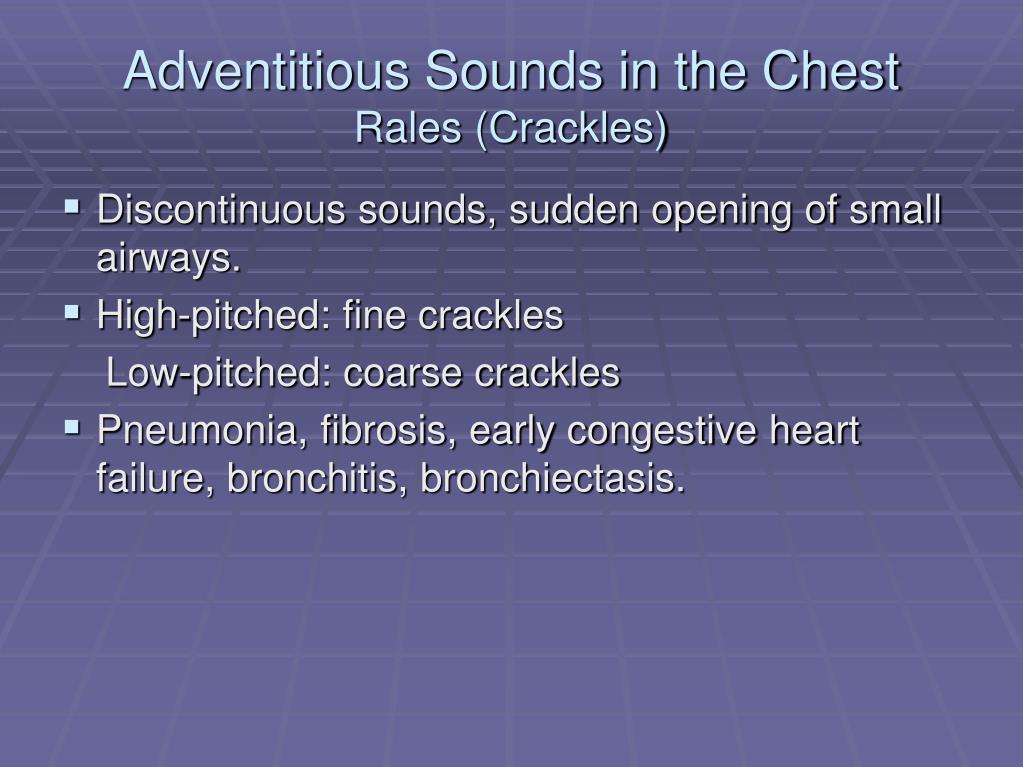


Allow the patient to set the pace to prevent hyperventilating, especially patients with breathing disorders like COPD. Have patient breathe in and out through mouth slowly while listening.Use the diaphragm of the stethoscope to auscultate at various locations (see images below).When listening to the posterior side of the chest the arms need to definitely be in the lap so the scapulae are separated. Have the patient sitting up with arms resting on lap.For example, are you hearing crackles or wheezes? Ask yourself is there anything “weird” heard along with the inspiration and expiration.The inspiration and expiration sound’s pitch, quality, duration, and if it is normal sounding.
#RALES LUNG SOUNDS FULL#
A full inspiration and expiration cycle.Start at the top and work your way to the bottom of the chest while comparing sides (watch the video for the technique).Listen to both the anterior and posterior sides of the chest.
#RALES LUNG SOUNDS HOW TO#
So, after you read this article be sure to watch the video and read the highlights on how to perform this assessment skill as well.ĭon’t forget to take the lung sounds quiz which will test you on lung auscultation landmarks and audio sounds. Still unsure about lung sounds? Check out this video for some audio auscultation practice.In the previous review, I covered how to assess heart sounds. Other common causes of stridor include foreign body aspiration, retropharyngeal abscess, peritonsillar abscess, allergic reaction, and epiglottitis. Croup is the most common cause of stridor in young children. Stridor is louder than wheezing and is more prominently heard during inspiration. It occurs as a result of turbulent flow in the upper airway caused by obstruction. Stridor is a high-pitched, continuous sound heard over the trachea. Wheezing is caused by conditions such as infection (croup, bronchiolitis), asthma, COPD, pulmonary edema, and foreign body aspiration. The degree of wheezing is not always correlated with disease severity. Wheezing is caused by airway constriction or narrowing, and is not usually affected by coughing. High-pitched wheezes have a squeaking quality, while low-pitched wheezes have a snoring or moaning quality. Wheezes are high or low-pitched sounds with a musical quality that occur in the inspiratory and/or expiratory phases of the respiratory cycle. These sounds are associated with disorders that cause increased airway secretions or reduced clearance of airway secretions. They are created by vibration of the walls of the airway and/or the rupture of fluid films. Ronchi are low-pitched, continuous sounds, with a snoring or rattling quality. Crackles may be auscultated in a number of medical conditions including, but not limited to, pneumonia and COPD. The greater the number of crackles, the more advanced the disease or illness. The number of crackles noted on exam directly correlates with disease severity. Coarse crackles are related to airway secretions.Ĭrackles are best heard on inspiration, although they may be noted throughout the respiratory cycle. Fine crackles are higher in frequency and shorter in duration than coarse crackles and are caused by the sudden opening of a closed airway. What kinds of adventitious sounds might you notice?Ĭrackles, or rales, are short, popping sounds noted on auscultation of the lung fields. In the case of pulmonary or airway pathology, you may hear abnormal, or adventitious, lung sounds. So, when you auscultate the lung fields, you can’t hear the entire expiratory process. This is because air moves out of the alveoli, towards the central airway during expiration. When you auscultate the lungs you should hear a 3:1 inspiration to expiration ratio. Although physiologically expiration is longer than inspiration, upon auscultation it will be shorter. Normal, or vesicular, lung sounds are soft and low-pitched in quality. When you examine a patient, a s you auscultate the lungs, you’re looking to see if the lung sounds are normal. So, whether you’re new to the nurse practitioner profession, or you’re a seasoned NP with years of experience, check out this super quick refresher on lung sounds. But, when a reader asked me to post a refresher on auscultation, even as an experienced NP I came away with a few new interesting tidbits of information. As nurse practitioners, many of us have been listening to lung sounds for years. It’s interesting how much you can learn with a review of the most basic skills.


 0 kommentar(er)
0 kommentar(er)
